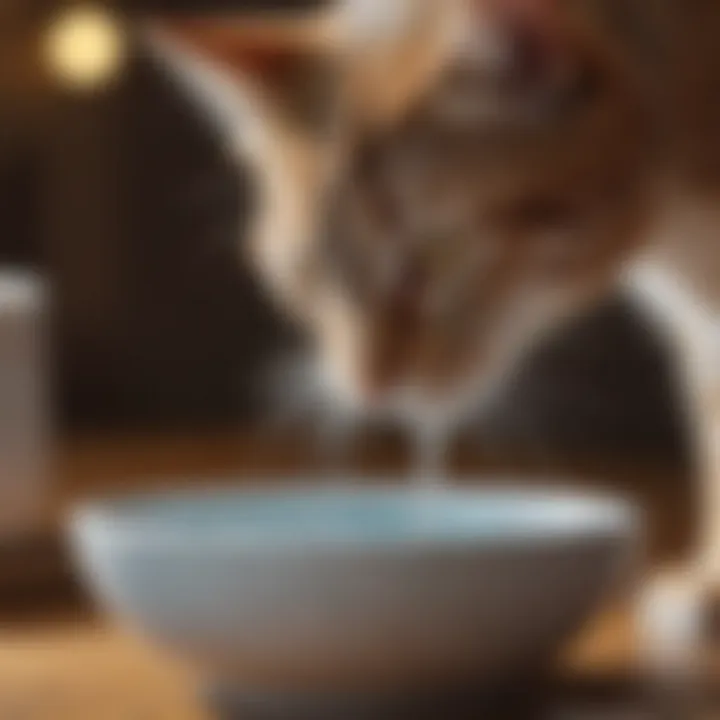Understanding Urinary Tract Infections in Cats


Intro
Urinary tract infections (UTIs) in cats are a significant concern for many pet owners. Understanding this issue requires not only knowledge of the causes and symptoms but also an awareness of the factors that contribute to feline health in a broader context. Delving into this topic involves examining nutrition, environment, and medical care, as all these elements play a role in prevention and management of UTIs.
Cats can be prone to urinary health issues, which can affect their overall well-being. Most notably, UTIs can lead to more serious conditions if left untreated. Therefore, it is crucial for cat owners to be aware of how to spot the signs of infection and what steps can be taken to maintain a healthy urinary tract.
Understanding Your Pet
Breed Traits
Different cat breeds can have unique health predispositions. For instance, breeds such as the Persian may experience different urinary health challenges compared to Siamese cats. Understanding these traits can help in anticipating potential health issues and adapting care accordingly.
Common Temperaments
Feline behavior varies significantly across breeds. Some cats might exhibit stress more easily, which can impact their urinary health. Stress can lead to behavioral changes that may result in inappropriate urination or other signs of discomfort. Recognizing these temperament traits allows owners to create a supportive home environment.
Special Needs
Certain cats may have additional health requirements. Older cats or those with chronic health conditions might need specialized diets or more frequent veterinary check-ups. Being proactive about potential health problems can aid in the prevention of UTIs.
Pet Care Essentials
Nutrition and Feeding Guidelines
Diet plays a pivotal role in maintaining urinary health. A high-quality diet that contains adequate moisture can help prevent the formation of crystals and stones. Consider feeding a mix of wet and dry food, ensuring that your cat stays hydrated. Always consult a veterinarian for tailored dietary advice.
Grooming Tips and Techniques
Regular grooming can contribute to overall health. While it is not directly linked to urinary health, keeping your cat's coat clean reduces stress and promotes general well-being. Grooming can also be a bonding experience, encouraging an active inspection of your pet's health, allowing you to notice any changes.
Health and Wellness
Routine vet visits are critical for early detection of health issues. Regular checks can help identify any urinary tract problems before they escalate. Vaccinations, dental care, and parasite control are also essential components of a comprehensive health plan for your cat.
Training and Behavior
Basic Training Techniques
Training your cat to use the litter box consistently is vital. Positive reinforcement through treats can encourage good habits. Additionally, ensuring the litter box is clean and placed in a quiet, accessible location can help prevent urinary stress.
Behavioral Problems and Solutions
Inappropriate urination can signal distress or health issues. By addressing the underlying cause—be it environmental stressors or potential medical issues—you can better manage your cat's well-being. Patience and understanding are important in addressing these problems.
Mental Stimulation Activities
Keeping your cat mentally engaged can also positively affect overall health. Providing toys that simulate hunting behavior can reduce stress and guard against behavioral issues linked to anxiety. Engage their instincts to keep them happy and healthy.
Engaging with Your Pet
Interactive Games and Toys
Encouraging playtime is beneficial for both physical and mental health. Toys that mimic prey can stimulate your cat's natural hunting instincts. Choose safe, durable toys to ensure hours of entertainment.
Safe Outdoor Activities
Supervised outdoor time can provide enrichment for cats. It allows them to explore nature safe from dangers such as traffic or other animals. Consider using a harness and leash to manage their movements while outdoors.
Family-Friendly Pet Interactions
Involving family members in pet care creates a strong bond and ensures your cat feels part of the family unit. Teaching children proper interaction with pets fosters respect and understanding of animal needs, promoting a harmonious living environment.
Pet Adoption and Integration
Choosing the Right Pet for Your Lifestyle
Before adopting, assess your lifestyle and the time you can commit. Some cats thrive in active households while others need a quieter environment. Understanding the right fit is essential for a healthy owner-pet relationship.
Preparing Your Home for a New Pet
Create a welcoming and safe space for your new cat. Ensure access to food, water, and a clean litter box. Safety from hazards is crucial in helping your new pet feel secure in their new home.
Tips for Smooth Intro
If you have other pets, a slow and manageable introduction process is important. Allowing pets to familiarize themselves with each other's scent before direct contact can help ease tension. Taking time in introductions helps create a peaceful multi-pet household.


Understanding the complexities of feline health is essential for maintaining your cat's urinary tract health and overall well-being. Educating yourself can ensure a long and happy life for your feline companion.
Prologue to Urinary Tract Infections in Cats
Urinary tract infections in cats represent a significant concern for pet owners. Understanding these issues is crucial for promoting both health and well-being in felines. The feline urinary system is complex, and several factors can lead to the development of UTIs. This introduction lays the groundwork for understanding UTIs, their causes, and implications.
When it comes to feline health, urinary problems often signal broader health issues. Early recognition and intervention can prevent severe complications and chronic conditions. Cat owners need to be aware of the risks associated with UTIs, as well as the signs that indicate a potential infection.
Definition and Overview of UTIs
A urinary tract infection, or UTI, refers to an infection that occurs in any part of the urinary system, which includes the kidneys, bladder, ureters, and urethra. For cats, UTIs are typically more common in the lower urinary tract, particularly the bladder and urethra.
Infections can be caused by bacterial growth in the urinary system. This growth often disrupts the delicate balance of microorganisms that typically inhabit the urinary tract, leading to inflammation and discomfort. Feline urinary health is sensitive, and various factors influence it, including age, diet, and overall health.
Recognizing a UTI early is essential for managing this condition effectively. Common symptoms may include frequent urination, straining to urinate, or even blood in the urine. These indications may signal that the cat requires veterinary attention.
Proper understanding of UTIs is essential not only for treatment but also for prevention. By implementing strategies that promote urinary health, such as adequate hydration and proper diet, cat owners can significantly reduce the likelihood of infection.
Anatomy of the Feline Urinary System
Structure and Function of the Urinary Tract
The urinary tract in cats consists of several critical components: the kidneys, ureters, bladder, and urethra.
- Kidneys: These two bean-shaped organs act as the body’s filter. They remove waste products and excess substances from the blood, producing urine.
- Ureters: Thin tubes connect each kidney to the bladder. They transport urine using muscular contractions.
- Bladder: This muscular sac stores urine until defecation. It expands as it fills and contracts during urination.
- Urethra: This tube carries urine from the bladder out of the body. In male cats, it is longer and more muscular than in females, a factor that can influence the risk of urinary blockages.
Each of these components plays a specific role, and disruption to any part can lead to urinary infections. Effective elimination of waste is vital for the overall health of cats. Monitoring changes in urination, such as frequency or straining, is crucial as they may signify an underlying problem.
Unique Characteristics of Cat Urinary Anatomy
Cats possess unique anatomical features that impact their urinary health. Some of these include:
- Concentrated Urine Production: Cats have an efficient kidney structure, capable of producing concentrated urine. This adaptation is crucial for survival in arid environments, but it may also lead to urinary crystals in some cases.
- Urethra Length and Structure: The male cat’s urethra is long and narrow, making urinary blockages a concern, especially with certain urinary conditions.
- Bladder Capacity: The bladder of cats has a limited capacity compared to some other animals, influencing how often they need to urinate.
Understanding these characteristics helps recognize potential issues before they escalate into serious infections. Feline anatomy is a segment of the puzzle in diagnosing and preventing urinary tract infections. As we analyze symptoms and treatment, knowledge of the urinary system remains crucial.
The anatomy of the urinary system is vital in understanding urinary health and the factors that can contribute to infections.
In summary, comprehension of the feline urinary system's structure and its unique characteristics is indispensable for every cat owner. Awareness leads to better monitoring of health and quicker interventions when issues arise.
Factors Contributing to UTIs
Understanding the factors that lead to urinary tract infections (UTIs) in cats is crucial for proactive pet care. Identifying these factors allows owners to take preventative measures and ensures prompt attention to the health needs of their feline companions. This section will delve into the specific contributors to UTIs, focusing on bacterial infections, underlying medical conditions, and dietary influences.
Bacterial Infections
Bacterial infections are often the primary cause of UTIs in cats. The urinary tract can become contaminated with bacteria from outside the body, leading to infection. Common culprits include Escherichia coli, which is normally found in the intestines. When these bacteria enter the urinary system, they can multiply, causing inflammation and discomfort.
The risk of bacterial infections increases significantly in cats with compromised immune systems. Stress, poor nutrition, and insufficient hydration can further weaken the immune response. As such, maintaining a healthy diet and ensuring access to fresh water at all times are important defensive measures against UTIs.
Underlying Medical Conditions
Certain underlying medical conditions can predispose cats to urinary tract infections. For example, diabetes mellitus can lead to an increased glucose level in the urine, which promotes bacterial growth. Similarly, urinary stones can obstruct the flow of urine, creating a favorable environment for infection.
Other conditions, such as hyperthyroidism or chronic kidney disease, can also disrupt normal urinary function. Regular veterinary check-ups are essential in identifying these conditions early and managing them effectively.
Dietary Influences
Diet plays a vital role in urinary health. A dry food diet may lead to less water intake, which increases the risk of urine concentration. This substantiates the need for a balanced diet that includes adequate moisture. Some cat owners may consider wet food as an option since it can help keep the urinary tract flushed and reduce concentrations of harmful bacteria.
Moreover, certain dietary supplements, like cranberry extract, might also help in maintaining urinary health. However, it's important to consult a veterinarian before introducing new dietary changes or supplements.
Main Takeaway: Understanding bacterial infections, underlying medical issues, and dietary factors can greatly decrease the likelihood of UTIs in cats. Optimal health requires a combination of good nutrition, proper veterinary care, and an observant owner.
Symptoms of Urinary Tract Infections
Understanding the symptoms of urinary tract infections (UTIs) in cats is critical for pet owners. Prompt recognition of these signs can lead to timely veterinary intervention, which is important for the health and recovery of the animal. UTIs, while common, often go unrecognized until they have progressed. Familiarizing oneself with the symptoms can empower owners, ensuring they can take action before the condition worsens.
Common Signs to Watch For
Cats are adept at masking discomfort, making it vital for owners to observe their behaviors closely. Several physical signs may indicate a UTI, including:
- Frequent urination: Cats may try to urinate more often but produce only a small amount each time.
- Straining to urinate: Painful urination can cause noticeable strain. This may be evident as the cat appears to be making an effort but struggles.
- Blood in urine: Hematuria may occur, where the urine appears pink or red due to the presence of blood.
- Strong odor: A foul smell may accompany the urine, indicating infection.
- Increased thirst: Often, affected cats will drink more water in response to infection.
Recognizing these signs forms the first line of defense against complications. Ignoring them could lead to severe health issues, including kidney damage. Keeping an eye on these symptoms ensures that the cat receives necessary care without delay.


Behavioral Changes in Affected Cats
Behavioral shifts can also provide clues about a cat’s health status. Recognizing behavioral changes associated with UTIs is as significant as identifying physical symptoms. Some changes to monitor include:
- Litter box avoidance: Cats may associate pain with using the litter box, leading them to avoid it altogether.
- Vocalization: Increased vocalization or crying when attempting to urinate can indicate distress and pain.
- Decreased appetite: Cats may exhibit a lack of interest in food due to discomfort.
- Hiding: An affected cat may withdraw and seek solitude, as they may feel vulnerable or unwell.
It is essential to acknowledge these behavioral changes as they may indicate not just a UTI but also other underlying issues.
By being vigilant about these signs and symptoms, pet owners can facilitate quicker diagnosis and treatment. This proactive approach significantly enhances the likelihood of full recovery and ensures feline comfort.
Diagnosis of UTIs in Cats
Accurate diagnosis of urinary tract infections (UTIs) in cats is essential for effective treatment and management. The feline urinary system is complex, and UTIs can cause significant discomfort and health issues when not addressed promptly. Understanding the diagnosis process helps cat owners recognize the importance of veterinary care in identifying these infections. It also reinforces the need for early intervention to prevent potential complications.
Veterinary Examination Process
The first step in diagnosing a UTI in a cat involves a thorough veterinary examination. Veterinarians will first take a detailed medical history from the owner. This information can include signs of illness, behavioral changes, and any pre-existing health conditions affecting the cat.
During the physical examination, the vet will assess the cat's overall health, focusing on the abdomen and urinary tract. They may look for pain or discomfort in the lower abdomen. Observations on body condition, hydration levels, and any visible abnormalities play a critical role.
Key aspects of the examination include:
- Palpation: Feeling the abdomen to check for any signs of swelling or pain.
- Temperature Measurement: Checking for fever that could indicate an infection.
- Behavioral Assessment: Noting any distress or discomfort exhibited during the examination.
This initial assessment sets the stage for further diagnostic testing, which is often necessary to confirm the presence of a UTI.
Laboratory Tests and Analysis
Once a UTI is suspected, veterinarians typically conduct several laboratory tests for confirmation. These tests are crucial for determining the specific cause of the infection and appropriate treatment protocols.
The most common tests include:
- Urinalysis: This test analyzes the cat's urine for signs of infection, such as the presence of bacteria, white blood cells, and crystals. The results can provide an initial indication of a UTI.
- Urine Culture: If a UTI is confirmed, a culture will determine the specific bacteria involved. This step is vital as it guides the choice of antibiotic treatment.
- Blood Tests: These may be ordered to assess overall kidney function and any underlying health issues that could contribute to urinary problems.
- Imaging: In some cases, imaging such as X-rays or ultrasounds may be necessary to identify abnormalities in the urinary tract, like stones or tumors.
Understanding these tests can help cat owners be more prepared for the veterinary visit and communicate effectively with their veterinarian.
Treatment and Management of UTIs
Urinary tract infections (UTIs) in cats can lead to serious health issues if not properly managed. Understanding treatment and management options is crucial for maintaining your cat's health. Effectively addressing UTIs requires a combination of different strategies, which ensures the overall well-being of your pet. This section explores the various methods available to treat and manage UTIs, including the role of antibiotic therapy and alternative treatment options.
Antibiotic Therapy
Antibiotic therapy is often the cornerstone in treating urinary tract infections in cats. When a veterinarian confirms a UTI through examinations and testing, they frequently prescribe an appropriate antibiotic to combat the bacterial infection. The selection of antibiotics depends on the bacteria identified and its sensitivity to specific drugs.
The use of antibiotics has several benefits:
- Targeted Action: Antibiotics can effectively kill or inhibit the growth of bacteria causing the infection.
- Restoration of Normal Function: With successful antibiotic treatment, your cat's urinary tract can return to normal function, alleviating discomfort.
- Prevention of Complications: Quick intervention through antibiotic use can prevent more severe complications, such as kidney infections or other systemic issues.
- Follow-Up Testing: After completing the antibiotic course, follow-up tests may be necessary to ensure that the infection has cleared completely.
However, there are important considerations to keep in mind:
- Potential Side Effects: While antibiotics can be effective, they may also cause side effects such as gastrointestinal upset or allergic reactions.
- Antibiotic Resistance: Overusing or misusing antibiotics can lead to resistant strains of bacteria. This emphasizes the importance of using antibiotics only under veterinary guidance.
- Full Course Completion: It is essential to administer the full course of antibiotics, even if your cat appears to improve before finishing the medication. Stopping early can lead to a return of the infection.
Alternative Treatment Options
In addition to antibiotic therapy, some cat owners may seek alternative treatments to manage urinary tract infections. These options can play a supplementary role but should not replace veterinary advice or prescribed treatments.
Some alternative treatments include:
- Herbal Remedies: Certain herbs like cranberry extract may help prevent bacteria from adhering to the urinary tract lining. Always consult with a vet about suitable herbs and dosages.
- Dietary Changes: Nutrition plays a pivotal role in urinary health. High-quality moist food increases water intake, reducing the concentration of urine and flushing out potential irritants. Some diets are formulated specifically to support urinary health.
- Probiotic Use: Probiotics might help restore a healthy balance of bacteria in the gut, which can indirectly benefit urinary health.
- Homeopathy: Some cat owners explore homeopathic options as a way to aid healing. However, scientific support for this approach varies considerably.
It is important to have a thorough discussion with a veterinarian about utilizing alternative treatments. Veterinary guidance ensures that these options are safe and appropriate in your cat's specific situation. Effective management of urinary tract infections is multidimensional, and understanding the balance between conventional and alternative treatments can help improve your cat's health outcomes.
Preventative Measures Against UTIs
Preventing urinary tract infections in cats involves understanding various elements that contribute to their occurrence. Effective prevention strategies can reduce the risk of UTIs significantly. By focusing on hydration, litter box hygiene, and nutrition, cat owners can help enhance their feline's urinary health and overall well-being.
Importance of Hydration
Hydration plays a critical role in the prevention of urinary tract infections. Cats that do not drink enough water may develop concentrated urine, which can lead to the formation of crystals and bacteria. Ensuring proper hydration can dilute urine and flush out any lingering bacteria. Several methods can encourage a cat to drink more:
- Water bowls: Maintain several clean water bowls around the house.
- Fountain: Utilize a cat water fountain to attract them to drink more often.
- Wet food: Incorporate wet cat food into their diet, as it contains more moisture than dry food.
Ultimately, promoting hydration is essential for maintaining a healthy urinary tract. The more water a cat drinks, the less likely they are to face issues related to UTIs.
Maintaining Proper Litter Box Hygiene


Litter box hygiene is another major factor in preventing UTIs in cats. A dirty or poorly maintained litter box can lead to bacteria accumulation, which may increase the risk of infections. It is crucial to clean the litter box daily and change the litter regularly. Here are some key considerations:
- Daily cleaning: Remove soiled litter daily to reduce odors and bacteria.
- Deep cleaning: Clean the litter box with soap and water weekly to eliminate any lingering bacteria.
- Litter choice: Use unscented litter to avoid irritating the cat’s urinary tract.
By ensuring a clean litter box, cat owners can help reduce the risk of urinary tract infections, promoting a healthier environment for their feline companions.
Dietary Recommendations and Nutrition
Nutrition is a fundamental aspect that influences urinary health. The right diet can help prevent urinary tract infections and maintain proper urinary function. Consider the following dietary recommendations:
- High-quality cat food: Choose foods specifically formulated for urinary health, which can promote proper hydration.
- Balanced nutrients: Ensure a proper balance of proteins, fats, vitamins, and minerals in their diet.
- Special formulations: Sometimes, veterinarians may recommend special diets that increase urinary pH or dissolve certain types of crystals.
Environmental Considerations
Environmental factors play a significant role in the health and well-being of cats, particularly in relation to urinary tract infections (UTIs). An understanding of these elements is crucial for cat owners to create a supportive habitat that minimizes the risk of UTIs. Factors such as stress, habitat design, and overall care are integral to maintaining feline urinary health.
Stress Factors Affecting Urinary Health
Stress can have a profound impact on feline health, including the development of UTIs. Cats are sensitive creatures, and various environmental changes can cause stress. Common stressors include:
- Changes in routine: Shifts in feeding, playtime, or sleeping patterns can unsettle a cat.
- New family members or pets: Introducing new humans or animals alters the social dynamics.
- Loud noises: Thunder, fireworks, or even loud appliances can scare a cat.
- Lack of hiding spaces: Cats need safe spaces to retreat when they feel threatened.
Stressful situations can trigger a physiological response in cats, leading to increased susceptibility to infections. Monitor your cat's behavior for any signs of stress, such as excessive grooming or hiding.
To mitigate stress, owners should strive to provide a calm environment. Implementing consistent routines and allowing cats to have their own spaces can reduce anxiety. This includes ensuring they have access to private areas where they can escape when overwhelmed.
Creating a Safe Habitat for Cats
A well-designed habitat is essential for a cat's physical and emotional safety. Here are some key elements to consider when creating a cat-friendly space:
- Stable Environment: Minimize sudden changes in the home. Introduce new items slowly and avoid rearranging furniture often.
- Litter Box Accessibility: Ensure the litter box is easily accessible and placed in a quiet location. Regular cleaning is essential to encourage use.
- Interactive Spaces: Provide climbing structures, scratching posts, and toys to engage their natural instincts. This keeps them occupied and less prone to stress.
- Comfort Items: Soft bedding and familiar toys can offer reassurance and comfort for your cat, helping to lower anxiety levels.
It is essential for chairs, furniture, and shelves to be free from potentially harmful objects. Ensure there are no choking hazards or toxic plants within reach. By creating an environment that supports your cat's natural behaviors, you will significantly reduce their stress levels and promote overall health, thereby lowering the risk of UTIs.
Understanding and implementing these environmental considerations can enhance a cat’s quality of life and reduce the likelihood of urinary tract infections. By focusing on stress reduction and habitat safety, cat owners can foster a healthy and conducive living space for their pets.
Monitoring Feline Health
Monitoring feline health is critical in preventing serious health issues such as urinary tract infections (UTIs). Understanding how to observe and evaluate your cat's well-being allows you to take proactive steps in health management. Regular monitoring can catch potential problems early, reducing the risk of complications and ensuring optimal health for your cat.
Routine Health Check-Ups
Routine health check-ups should not be overlooked. These examinations allow veterinarians to assess your cat's overall health and identify any emerging issues. During these visits, a vet will typically perform a thorough physical examination. They will check vital signs, skin, fur quality, and dental health, among other things. Regular vaccinations and preventative care are also discussed. The frequency of these check-ups may depend on your cat's age, health status, and any pre-existing conditions.
Key benefits of routine health check-ups include:
- Early detection of illnesses.
- Monitoring of weight and nutrition.
- Updating vaccinations to ensure ongoing protection.
- Getting professional guidance on dietary needs and lifestyle adjustments.
By keeping these appointments, you position yourself to catch signs of UTIs before they escalate into serious health concerns.
Recognizing Early Signs of UTI Recurrence
Being attentive to the signs of UTI recurrence in your cat is paramount. Cats may not always exhibit obvious symptoms, but some subtle indications can alert you to potential issues. Common early signs to watch for include:
- Increased frequency of urination.
- Straining or discomfort while urinating.
- Blood in the urine, or changes in urine color.
- Licking of the urinary area more than usual.
Additionally, changes in behavior such as withdrawing from social interaction or alterations in grooming habits can also suggest trouble.
Immediately consulting a veterinarian when these symptoms appear can lead to timely intervention. In doing so, you not only help manage your cat's discomfort but also reduce the risk of the condition becoming more severe.
Monitoring your cat’s health is not just about treatment; it's about fostering a preventive approach for the well-being of your furry companion.
In summary, consistent health monitoring through routine check-ups and keen observation fosters better health outcomes for your cat, ultimately leading to a healthier and happier life.
Closure and Key Takeaways
In this article, we explored the various aspects of urinary tract infections in cats, aiming to provide a comprehensive understanding of this prevalent health issue. Awareness and knowledge are crucial components of managing your cat's wellbeing. Understanding UTIs enhances the ability of pet owners to recognize symptoms early and take appropriate steps to mitigate health risks. Investing time in learning about this topic helps in developing informed decisions regarding your pet's care.
"Being proactive about your cat's health can prevent serious complications down the road."
Summary of Important Points
The following key takeaways summarize the critical aspects addressed in this article:
- Definitions and Understanding: UTIs occur when bacteria infiltrate the urinary tract, leading to discomfort and potential complications.
- Anatomy Insight: The structure of a cat's urinary system is unique and plays a significant role in how UTIs develop.
- Contributing Factors: Various elements, including bacterial presence, existing medical conditions, and dietary choices, are significant in the onset of UTIs.
- Recognizable Symptoms: It is essential to be aware of signs such as frequent urination, discomfort while urinating, and changes in behavior or litter box habits.
- Diagnosis and Treatment: A veterinary examination, complemented by laboratory analysis, confirms UTIs, while appropriate treatment often includes antibiotics.
- Preventative Measures: Proper hydration, hygiene, and nutrition are paramount for reducing the risk of UTIs in cats.
Final Thoughts on Cat Health Maintenance
Maintaining your cat's health is a continuous commitment that requires attention to various factors.
- Regular Check-Ups: Routine veterinary visits allow for early detection of potential health issues, including UTIs.
- Patient Monitoring: Owners should remain vigilant for any signs of urinary issues. Recognizing symptoms early can lead to swift intervention.
- Environment Influence: A stress-free environment contributes significantly to your cat’s overall health. Taking steps to offer a peaceful habitat is beneficial.
Addressing the factors that lead to urinary tract infections is essential in promoting your cat's health. Remember, informed and proactive measures are key to ensuring your feline remains happy and healthy.



